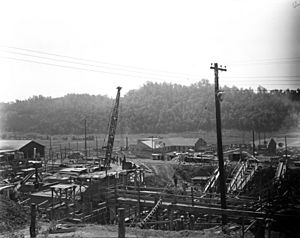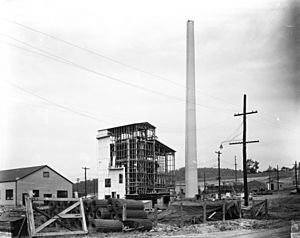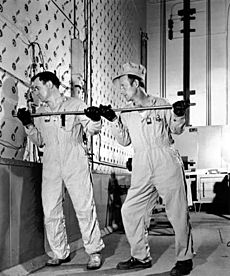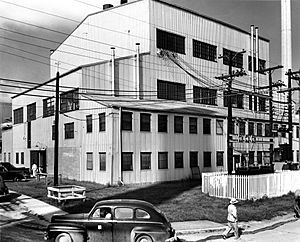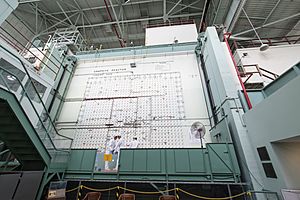X-10 Graphite Reactor facts for kids
|
X-10 Reactor, Oak Ridge National Laboratory
|
|
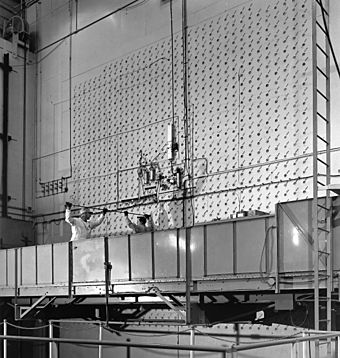
Workers in the Graphite Reactor use a rod to push fresh uranium slugs into the reactor's concrete loading face.
|
|
| Location | Oak Ridge National Laboratory |
|---|---|
| Nearest city | Oak Ridge, Tennessee |
| Area | less than 1-acre (0.40 ha) |
| Built | 1943 |
| NRHP reference No. | 66000720 |
Quick facts for kids Significant dates |
|
| Added to NRHP | October 15, 1966 |
| Designated NHL | December 21, 1965 |
| X-10 Graphite Reactor | |
|---|---|
| Reactor concept | Research reactor (uranium/graphite) |
| Designed and built by | Metallurgical Laboratory |
| Operational | 1943 to 1963 |
| Status | Decommissioned |
| Main parameters of the reactor core | |
| Fuel (fissile material) | Metallic natural uranium |
| Fuel state | Solid (pellets) |
| Neutron energy spectrum | Information missing |
| Primary control method | Control rods |
| Primary moderator | Nuclear graphite (bricks) |
| Primary coolant | Air |
| Reactor usage | |
| Primary use | Research |
| Remarks | The world's second artificial nuclear reactor. |
The X-10 Graphite Reactor is an old nuclear reactor located at Oak Ridge National Laboratory in Oak Ridge, Tennessee. It was also known as the Clinton Pile or X-10 Pile. This reactor was the second artificial nuclear reactor ever built, after Enrico Fermi's Chicago Pile-1. It was also the first one designed to run continuously.
The X-10 Graphite Reactor was built during World War II as part of the Manhattan Project. This secret project aimed to create atomic bombs. While the Chicago Pile-1 showed that nuclear reactors were possible, the Manhattan Project needed much more powerful reactors. They also needed ways to separate the plutonium created in the reactors from uranium and other radioactive materials.
The X-10 project was a crucial step. It was a "semi-works" plant, meaning it was a smaller version of a full production plant. Here, scientists and engineers could test new methods and train people. The X-10 Graphite Reactor used air for cooling and nuclear graphite to slow down neutrons. It was fueled by pure natural uranium metal.
Construction of the X-10 plant began on February 2, 1943. The reactor started working on November 4, 1943. It produced its first plutonium in early 1944. This plutonium was sent to the Los Alamos Laboratory and helped scientists understand how to design atomic bombs. The X-10 reactor also gave valuable experience to many engineers and operators.
The X-10 operated as a plutonium production plant until January 1945. After that, it was used for research. It also produced radioactive isotopes for science, medicine, industry, and farming. The reactor was shut down in 1963. In 1965, it was named a National Historic Landmark.
Contents
Why the Reactor Was Built
The idea of building a nuclear reactor came after German chemists discovered nuclear fission in 1938. This discovery showed that a controlled nuclear chain reaction was possible with uranium. Scientists like Enrico Fermi and Leo Szilard at Columbia University began to explore this idea.
Szilard wrote a secret letter to U.S. President Franklin D. Roosevelt. He explained the possibility of atomic bombs and warned about Germany potentially building them. Albert Einstein also signed the letter, which helped get the U.S. government to support nuclear research. This research eventually became the Manhattan Project.
In 1941, Arthur Compton, a Nobel-Prize-winning physicist, was asked to lead the plutonium project, called X-10. His team's goal was to:
- Build reactors to change uranium into plutonium.
- Find ways to separate plutonium from uranium.
- Design and build an atomic bomb.
Compton decided to bring all the research teams together at the Metallurgical Laboratory at the University of Chicago.
Choosing a Location
By June 1942, the Manhattan Project was ready to start building production facilities. It was a big step from lab experiments to large-scale production. So, they decided to build a smaller "pilot plant" first.
They wanted the pilot plant to be close to the Metallurgical Laboratory in Chicago. However, for safety and security, it couldn't be in a crowded city. A site in the Red Gate Woods near Chicago was chosen for a research reactor. A much larger site in Oak Ridge, Tennessee, was selected for the main production facilities.
Later, it became clear that the pilot plant would be too big for the Argonne site. So, the plutonium pilot facilities, known as a "semi-works," would be built at the Clinton Engineer Works in Tennessee.
The Oak Ridge site was chosen for several reasons:
- It was far enough from people in case of accidents.
- It was still close to workers and easy to reach by roads and railways.
- The weather was mild, allowing construction year-round.
- The land had good foundations for building.
- It had plenty of electricity from the Tennessee Valley Authority and cooling water.
In December, it was decided that the main plutonium production plants would be built at the even more remote Hanford Site in Washington state. Despite this, the X-10 semi-works was still built at Oak Ridge. It would be used for testing and training.
How the Reactor Was Designed
When building a reactor, key decisions are made about the fuel, coolant, and neutron moderator.
- Fuel: Only natural uranium was available.
- Moderator: Graphite was chosen to slow down the neutrons.
- Coolant: This was a big discussion. The fuel would be covered in aluminum, so the reactor couldn't get hotter than 200 degrees Celsius. Initially, helium gas was considered for the main production plants because it didn't absorb neutrons.
However, not everyone agreed. Scientist Eugene Wigner strongly supported using water for cooling. Even though water absorbed some neutrons, he believed a water-cooled reactor would still work. Water-cooled designs were also easier to build.
On December 2, 1942, Fermi's Chicago Pile-1 reactor successfully started working. This showed that the reactor design was even better than expected. This made air-cooled and water-cooled designs much easier to build. In January 1943, Wigner's team gave DuPont (the company building the reactor) plans for a water-cooled reactor.
By February, air cooling was chosen for the X-10 pilot plant. Even though X-10 wouldn't be exactly like the larger production reactors, it was still very important. It would provide plutonium for research and help find any problems before the big plants were built. It was also used for training future reactor operators.
Building the Reactor
Even before the reactor design was finished, DuPont started building the plutonium semi-works on February 2, 1943. This isolated area, called X-10, was about 10 miles southwest of Oak Ridge. The site included research labs, a chemical separation plant, and training facilities.
Building the reactor faced many challenges:
- Ground problems: A large pocket of soft clay was found, requiring extra foundations.
- Material shortages: It was wartime, so getting building materials was hard.
- Worker issues: There weren't enough skilled workers, and many left or didn't show up. This was partly because housing in Oak Ridge was still being built.
- Bad weather: There was unusually heavy rainfall in July 1943.
Crews began stacking the large graphite blocks in September 1943. About 700 tons of graphite were used. Uranium fuel came as metal pieces. These were shaped into cylindrical "slugs" and then "canned." Canning meant sealing the uranium in aluminum cans. This protected the uranium from corrosion and kept radioactive gases from escaping. Alcoa started canning the slugs in June 1943.
The chemical separation plant was also built before the best way to separate plutonium was chosen. They decided to use a method called the "bismuth phosphate process." This plant had six cells, separated by thick concrete walls. Workers operated the equipment remotely from a control room because of the high radioactivity. The plant was finished on November 26, 1943.
How the Reactor Worked
The X-10 Graphite Reactor was the second artificial nuclear reactor in the world. It was the first designed to run continuously. It was a huge block of nuclear graphite cubes, 24 feet long on each side, weighing about 1,500 tons. This graphite acted as a moderator. The reactor was surrounded by 7 feet of thick concrete to protect against radiation. In total, the reactor was 38 feet wide, 47 feet deep, and 32 feet high.
It had 36 horizontal rows with 35 holes each. Uranium fuel slugs were inserted into metal channels behind these holes. An elevator helped workers reach the higher holes. Only about 800 of these channels were ever used.
The reactor was controlled by cadmium-clad steel control rods. Cadmium absorbs neutrons, which can slow down or stop the nuclear reaction.
- Three 8-foot rods dropped vertically into the reactor to quickly halt it if needed (the "scram" system).
- Four other rods, made of boron steel, went horizontally into the reactor from the north side. Two were controlled by hydraulics, and two by electric motors.
The cooling system used three electric fans that moved 55,000 cubic feet of air per minute. On colder days, the reactor could run at a higher power level because the outside air was cooler. After passing through the reactor, the air was filtered to remove radioactive particles. Then, it was released through a 200-foot chimney. The reactor was operated from a control room on the second floor.
The reactor started working on November 4, 1943, with about 30 tons of uranium. A week later, it was increased to 36 tons, producing 500 kilowatts of power. By the end of November, the first 500 milligrams of plutonium were created. The reactor usually ran 24 hours a day, with 10-hour shutdowns each week for refueling.
The first batch of irradiated slugs was processed on December 20, 1943. This allowed the first plutonium to be produced in early 1944. The fuel slugs were pure metallic natural uranium, sealed in aluminum cans. Each channel held between 24 and 54 fuel slugs. To load them, workers used long rods to push them into the front of the reactor. To unload them, they were pushed through to the other side, where they fell into a 20-foot-deep pool of water for radiation shielding. After weeks of storage underwater to allow radioactivity to decrease, the slugs were sent to the chemical separation building.
By February 1944, the reactor was irradiating a ton of uranium every three days. Over time, the reactor's power was increased to 4,000 kilowatts by July 1944. The X-10 semi-works produced plutonium until January 1945. After that, it was used for research. By this time, 299 batches of irradiated slugs had been processed.
The X-10 reactor provided the Los Alamos Laboratory with the first important samples of plutonium. Studies showed that this plutonium contained an impurity called plutonium-240. This meant that a simple "gun-type" atomic bomb using this plutonium would likely explode too early. Because of this, Los Alamos had to develop a much more complex "implosion-type" atomic bomb.
The X-10 chemical separation plant also proved that the bismuth-phosphate process worked. This process was then used in the full-scale separation facilities at Hanford. Overall, the X-10 reactor and chemical plant gave invaluable experience to the engineers and workers who later moved to the Hanford Site.
Peaceful Uses of the Reactor
After World War II ended, the X-10 Graphite Reactor became the first facility in the world to produce radioactive isotopes for peaceful uses. On August 2, 1946, a small container of carbon-14 was given to a hospital for medical use. Later, shipments of other radioisotopes, like iodine-131 and phosphorus-32, were sent out. These were used for scientific research, medicine, industry, and agriculture.
The X-10 Graphite Reactor was shut down on November 4, 1963, after 20 years of operation. It was named a National Historic Landmark in 1965. In 1969, it was recognized for its contributions to materials science. In 2008, it was named a National Historic Chemical Landmark. Today, visitors can see the control room and reactor face during tours offered by the American Museum of Science and Energy.
Similar Reactors Around the World
The X-10 Graphite Reactor's design influenced other reactors built around the world.
- Brookhaven National Laboratory (BNL) Graphite Research Reactor: This was the first nuclear reactor built in the United States after World War II. Construction started in 1947, and it began operating in 1950. It was a 700-ton graphite cube fueled by natural uranium. Its main purpose was research in medicine, biology, chemistry, physics, and nuclear engineering. A major discovery there was the production of molybdenum-99/technetium-99m, which is now used in millions of medical tests each year. The BNL reactor was shut down in 1969.
- Windscale Reactors (UK): In 1946, Britain decided to build air-cooled graphite reactors similar to X-10 to produce plutonium for weapons. They used natural uranium and graphite as a moderator. Air cooling was chosen because other coolants were either unavailable or too risky. Construction began in 1947, and two reactors started operating in 1950 and 1951. Both were shut down after a serious fire in 1957. These were the last major air-cooled reactors for plutonium production.
- Belgian BR-1 Reactor: As of 2016, another reactor with a similar design to X-10 is still running in Mol, Belgium. This 4-megawatt research reactor started operating in 1956. It is used for scientific purposes, such as analyzing materials, doing physics experiments, and producing special silicon for electronics.
Images for kids
See also
 In Spanish: Reactor de grafito X-10 para niños
In Spanish: Reactor de grafito X-10 para niños


